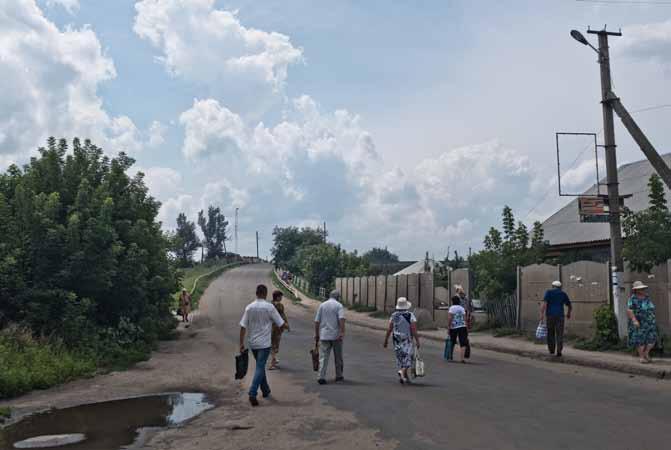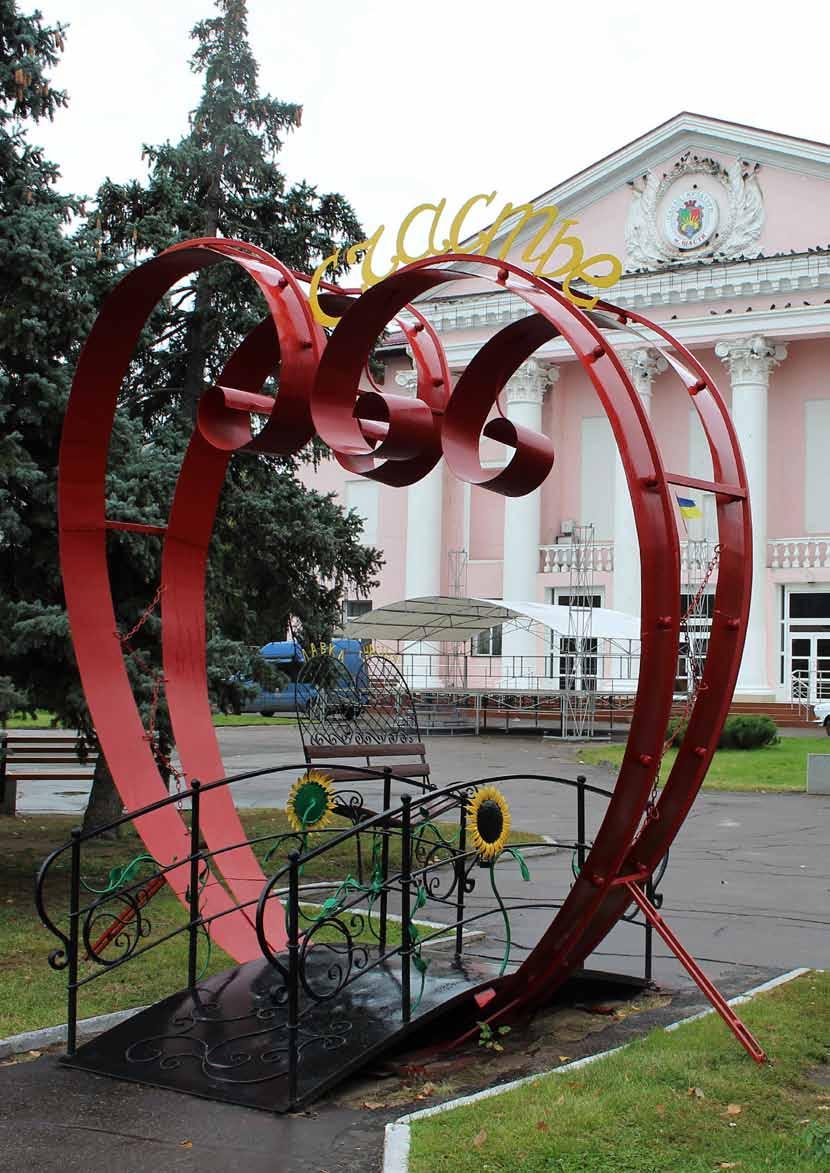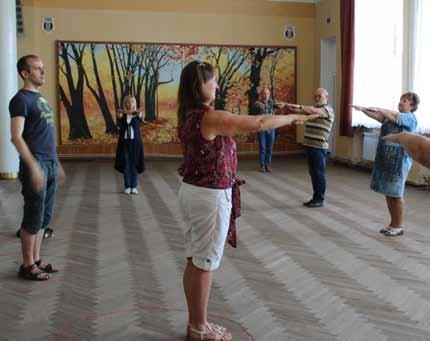
12 minute read
Fields of Civil Society Activism
types and calibers, causing significant damage to its infrastructure and housing. The residential quarter
around Lomonosov and Lebedinsky streets was particularly affected. From 13,774 inhabitants as of
Advertisement
January 2014 22 , the population of Stanytsia had dropped to approximately 7,200 by August 2015 23 .
Meanwhile, most of the houses that are still inhabited, have been repaired. The whole part of the town that faces the frontline has new roofs. Still, the traces of war are more visible here than in any other urban settlement of Luhansk district. Housing reconstruction in Stanytsia Luhanska has been possible mainly due to international aid.
The Bridge
Even in the midst of crossfire, pedestrians and public transport continued to pass over the last bridge
between Stanytsia and Luhansk. In early 2015, the Ukrainian administration closed the bridge to traffic. 24
On March 19, 2015, it was heavily damaged in a severe shootout between the two sides, leaving Stanytsia
virtually cut off from its main market, Luhansk, which remained under the control of illegitimate
paramilitary units. 25
Later in 2015, the authorities established an official entry-exit checkpoint (EECP) across the heavily
damaged bridge – the only one in the whole Luhansk region. Unlike the operating EECPs in Donetsk
region, Stanytsia Luhanska only allows pedestrians to cross. The EECP constitutes a floodgate of people
crossing to visit relatives and friends, to buy and sell goods, but most importantly, to gain access to
Ukrainian pensions and other subsidies. In November 2014, Ukrainian authorities ceased to pay social
benefits on non-government controlled territory. Until today, residents of the occupied territories have to
register as Internally Displaced Persons (IDPs) on government-controlled territory and personally verify
their identity in a bank every other month to receive pension or other subsidies. 26 Consequently, senior
citizens are flocking into the town every workday to verify themselves, pick up their pension and go
shopping. This so-called “pension tourism” 27 has fundamentally changed the face of Stanytsia Luhanska,
and causes tension and animosity not only from the locals in Stanytsia Luhanska who have to queue in the banks among hundreds of residents from Luhansk and “LPR”, but also resentment from many Ukrainians who see them as opportunists taking advantage of the Ukrainian social system.
The destroyed bridge people had to cross on foot remained a key humanitarian concern for several years. Although temporary wooden ramps were built by the International Committee of the Red Cross in December 2017, crossing remained dangerous and troublesome, especially for the elderly and disabled
http://database.ukrcensus.gov.ua/PXWEB2007/ukr/publ_new1/2014/publ2014.asp https://www.austausch.org/files/DRA/Publikationen/Положение-гражданского-населения-в-отдельных-районах-донецкой-илуганской-областей.pdf, p.39 https://www.kyivpost.com/article/content/war-against-ukraine/blast-destroys-river-bridge-in-ukraines-stanytsia-luhanska-383999.html https://www.kyivpost.com/article/content/war-against-ukraine/blast-destroys-river-bridge-in-ukraines-stanytsia-luhanska-383999.html http://khpg.org/ru/index.php?id=1475581147#_Toc463056294 http://khpg.org/ru/index.php?id=1475581147#_Toc463056294
was the bridge repaired and the road leading from the EECP to the bridge paved. Still, it is not open
for vehicles. However, a bus and two electric cars of the United Nations Refugy Agency UNHCR carry
individuals with limited mobility over the approximately 800 meters that divide the Ukrainian EECP
from the bridge. 29
Approximately 10-15,000 people cross the EECP in Stanytsia Luhanska every day. Although there are no official statistics on population numbers, sources in the district administration say that approximately 10,000 people currently live in Stanytsia (January 2020). Two small medical points operate during the opening hours of the EECP – one before and one after the Ukrainian passport control post.
Conditions for civil society
Stanytsia Luhanska has a district administration, three schools, several banks, and a hospital. The hospital, however, does not possess modern medical equipment. For advanced treatments, people go to Luhansk or larger Ukrainian cities.
Moreover, there is a House of Culture with a library, a museum, and a sports stadium. The library was repeatedly hit by shelling and is currently under renovation (see right picture).
Numerous international organisations are active in Stanytsia. They mainly provide help with the maintenance and repair of houses and town institutions. Some offer humanitarian aid. The NGOs Proliska and Norwegian Refugee Council (NRC) have offices in Stanytsia.
Our respondents claim that cultural leisure time activities are needed. The fact that there are no opportunities for joint activities and entertainment affects their psychological situation, they argue. Particularly young people lack opportunities to meet and be inspired. Students try to organize activities themselves. The settlement does not have a center for activists or a youth center. Vostok-SOS has tried to create activity centers and centers of legal aid, but has faced problems with funds for activities, as well as with finding experienced and responsible people to run such a center.
According to our experience, it is not easy to work in Stanytsia Luhanska. People seem much more shy and hesitant to speak to strangers. Many prefer not to take sides in the conflict, or even to talk about it.
There is still a significant lack of job opportunities. Being separated from Luhansk, the town has not succeeded in developing trade and exchange with other towns and regions on Ukrainian controlled territory. People in Stanytsia Luhanska seem to suffer from stress, trauma and feelings of insecurity, and lack sustainable support in overcoming the difficult past six years.
The so-called “pension tourism” affects the town (see picture below). Our participants report that during the daytime, they do not have the impression that it is “their city” – only in the evening. During the working hours of offices and banks, the town is so crowded that they avoid going shopping, running errands, or doing other activities. After 4pm, the face of the town changes completely – most of the “tourists” leave, as the EECP closes at 6pm. The town becomes empty and silent. This contrast is characteristic of Stanytsia.

which includes the area of Stanytsia Luhanska. Both sides withdrew armed forces and weapons, while experts conducted partial demining.
The disengagement area in Stanytsia Luhanska is located on both banks of the Siverskyi Donets river, which serves as a natural barrier. It includes the EECP, some of the territory surrounding the EECP, and the residential quarter around Lomonosov and Lebedinsky streets. A railway bridge across the Siverskyi Donets and the river itself separate this area from the territories controlled by armed groups of the so-called “LPR.”
Local residents in Stanytsia Luhanska associate disengagement with the absence of military personnel and vehicles, rather than with less shelling, because the settlement has not been shelled for a while now. But both locals and observers note that despite the disengagement, Russianbacked armed groups have been setting up firing positions at dominant heights on the border of the disengagement area. Shelling outside Stanytsia Luhanska has often been reported.
The agreement on disengagement provides for a mutual “mirror” withdrawal of both the Ukrainian Armed Forces (UAF) and the Russian-backed armed groups of the so called “LPR”, from areas measuring about 2x2 kilometers. Accordingly, disengagement measures were taken in fall 2019 in three pilot zones, which had been determined in 2016 by the Trilateral Contact Group in Minsk, and
Disengagement
The government does not ensure the safety of people in the demilitarized zones and seems to be unable to guarantee an unhindered operation of public/municipal authorities, the safety of civil servants and their families, or the safekeeping of public registers that may potentially be located in the new disengagement areas. The security measures currently in place are declarative and insufficient; the police does not properly patrol the demilitarized zones. The authorities do not offer people at risk living in the demilitarized zones any alternative solutions, such as assistance with relocation, to ensure their safety. 30

Shchastya
The town of Shchastya (whose name means happiness in Ukrainian) is located to the north of Luhansk, across the river Siverskyi Donets. Originally founded as a village in 1754, Shchastya grew immensely with the construction of the Luhansk Power Plant north of the settlement, which began in 1952. In 1958, the construction was completed. Shchastya has officially been a town since 1963.
Before the war, Shchastya was one of Luhansk´s administrative districts and a popular summer house
area. In late April 2014, the town came under the control of the self-proclaimed “Lugansk People´s
Republic” (“LPR”) until it was retaken by the volunteer battalion “Aidar” on June 14 of the same year.
In October 2014, the government changed the administrative division in the Luhansk and Donetsk
regions, to ensure the continued functioning of local administration, as many towns and settlements now belonged administratively to those districts under the control of the “LPR”. Currently Shchastya is administrated by a civil-military administration that is one of 20 at regional, district and settlement levels which are operating in the Luhansk and Donetsk regions. 31
The thermal power plant, running on sub-bituminous coal and natural gas, is the core industry in the
small town. It employs more than 1000 32 people and is capable of feeding electricity to 98 percent of the
region 33 . It belongs to the company “DTEK Vostokenergo”, which is owned by Rinat Akhmetov 34 . Almost
everyone in the town is somehow connected to the plant – either s/he works there, or used to work there, or has family members working there. Currently, the power plant is under threat of closure. This would entail an enormous loss of jobs and a huge change in the social and economic situation of Shchastya and its inhabitants.
In the conflict, the power plant has been of crucial significance. 35 As the only electricity source in the
Luhansk region, it provides power to approximately one million people in the Ukrainian government
controlled area (GCA). Until 2017, it also supplied electricity to the non-government controlled (NGC)
areas of the region. 36 Throughout summer and fall 2014, the Russian-backed armed forces unsuccessfully
tried to recapture the power plant. Since 2017, the NGC territories have relied on an energy supply from
the Russian Federation. 37
Located on the banks of the Siverskyi Donets, the plant is situated right in the crossfire between Ukrainian troops and Russian-backed separatists. Despite frequent shelling throughout the conflict, the
31 32 33
34 35 36 37 https://24tv.ua/ru/na_luganshhine_sozdali_novuju_voenno_grazhdanskuju_administraciju_n1098755 https://svoi.city/read/history/48451/zarabotki-v-schaste https://www.kyivpost.com/article/content/war-against-ukraine/sbu-captured-russian-special-ops-troops-had-mission-to-ready-armedtakeover-of-schastya-389122.html https://en.wikipedia.org/wiki/Rinat_Akhmetov#Political_activity https://hromadske.radio/ru/news/2014/12/04/pri-popadanii-v-tes-v-schaste-mozhet-byt-tehnogennaya-katastrofa-ekspert https://24tv.ua/ru/luganskaja_tjes_v_ozhidanii_tragedii_n588123 https://www.vedomosti.ru/opinion/articles/2017/04/28/687878-podklyuchenie-rossii
of Luhansk region without electricity for days. 38 A serious hit to the hydrogen or oxygen containers of
the plant could cause an explosion similar to a hydrogen bomb, resulting in a large-scale environmental
catastrophe. 39
During the first years of the conflict, the plant continued to receive coal from the NGC territories and
Russia, as there is no rail connection on controlled territory that could ensure continuous coal supply.
When Russia issued an embargo on exporting coal and petroleum to Ukraine in November 2018, the
power plant had to switch to natural gas. 40
Conflict, occupation, violence against local inhabitants
In spring and early summer 2014, the time of occupation and intense warfare, a lot of residential
buildings were severely damaged and abandoned. 41 Public facilities barely worked and the town was
affected by frequent blackouts. During the active phase of hostilities, the area around the town and the power plant were partly mined. There are still mines along the military positions.
During the fights and the occupation, a significant part of the population fled the settlement. Since
2015, however, residents have been returning. Many residents of Luhansk have registered themselves
as IDPs in Shchastya despite living in Luhansk, to be able to receive pensions or social support. The
last serious artillery attack on the town was recorded in 2016. 42
Shchastya is one of the potential areas for the disengagement process, as it has one of the only intact automobile bridges across Siverskyi Donets. The “LPR” suggests opening a frontline crossing point (known as an EECP) in Shchastya. The Ukrainian authorities, however, fear that this would enhance the risk of the power plant being taken over. The authorities of Luhansk region instead insist on opening an EECP in Zolote, and have built the necessary infrastructure. That said, the “LPR” has been blocking the implementation of this idea, insisting on opening the EECP in Shchastya. The bridge has also served as place for exchanging prisoners between the Ukrainian government and pro-Russian separatists.
Civil society
Shchastya possesses a stable institutional base for civil society. It has a formed local government, which functioned even during the period of the most intense hostilities, albeit without significant influence on the actions. The civil-military administration managed to restore the damaged infrastructure and most of
https://24tv.ua/ru/chast_luganshhiny_okutala_temnota_n599840 https://hromadske.radio/ru/news/2014/12/04/pri-popadanii-v-tes-v-schaste-mozhet-byt-tehnogennaya-katastrofa-ekspert https://www.radiosvoboda.org/a/donbass-realii-luhanska-tes/29588056.html https://uk.wikipedia.org/wiki/%D0%91%D0%BE%D1%97_%D0%B7%D0%B0_%D0%A9%D0%B0%D1%81%D1%82%D1%8F https://ru.krymr.com/a/27959076.html
There are two schools, a technical high school, a hospital and an ambulance station in the town. All of
them have continued working despite the severe hostilities, except in 2014, when educational facilities
ceased to operate on several occasions. Even under shelling, the hospital provided healthcare to civilians
and soldiers. Its building has been damaged several times 43 .
Throughout the conflict, civil society, previously having been part of the regional center Luhansk, demonstrated strong potential for self-government. There are several civic and community initiatives that have grown into community-based and civil society organizations. These organizations have been involved in project implementation and are actively involved in the life of the city.

There is an operating House of Culture (Dom Kultury, DK) in Shchastya that offers space for various activities, such as concerts, training sessions, open meetings, and other public events. NGOs can rent rooms in the DK for training, presentations and other events.
One of the local initiatives created after the conflict outbreak is the civic organization “Kulturna fortetsya” (Cultural fortress). Working on a voluntary basis, its members organize various educational and recreational events for local children and adults: classes for children, a film club and other movie screenings, and discussions and open air talks on particular topics. They make use of a small room of one of the municipal buildings. For events they use the central park and the House of Culture.
Throughout the summer of 2018, “Kulturna fortetsya” together with Vostok-SOS implemented the “Tviy prostyr” project, creating an open-air venue where about 30 events for the town residents took place. Among them was the youth festival “May 32 nd ” (see pciture on page 22) that gathered about
one hundred young locals. In the past three years, an initiative group from the House of Culture organized small local festivals, together with public organizations and educational institutions of the town. In 2019, the festival “Z kraini to Ukraine”, which belongs to a chain of festivals travelling from town to town, took place in Shchastya.




